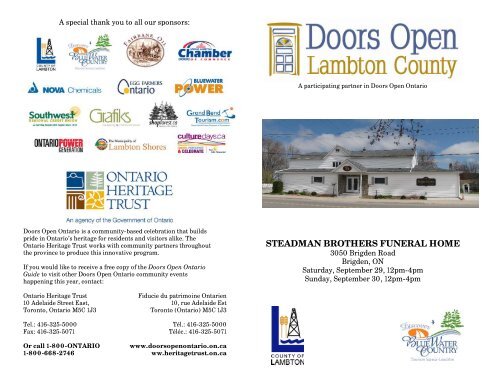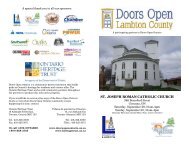steadman brothers funeral home - Doors Open Lambton County
steadman brothers funeral home - Doors Open Lambton County
steadman brothers funeral home - Doors Open Lambton County
You also want an ePaper? Increase the reach of your titles
YUMPU automatically turns print PDFs into web optimized ePapers that Google loves.
storey of the front (west side) were removed and replaced by one largewindow1975 – addition of the front foyer and a new chapel on the north side– now used as the North Visitation/Gathering Room – additions onthe north, south and east elevations expanded the second storey –basement was added under the front foyer and a deeper basement wasdug under the original <strong>home</strong> – this permitted a renovation of thecasket room and the addition of basement washrooms2003 – addition of a new garage and preparation room on the eastside2007 – addition on south side adds the South Visitation/GatheringRoom – flat roof on the front foyer is changed to a peaked roof – newcanopy incorporated into the roof over the west entrance –renovations allow wheelchair accessibility2009 – renovation of the shed/garage directly east of the <strong>funeral</strong><strong>home</strong> into a garage for the fleet of hearses and vehicles as well as anequipment storage building – the old shed had formerly belonged toDean Core, who owned the Ford Dealership (located at 3026 BrigdenRoad) – it was located in the lot immediately to the north (currentlyused as a parking lot) – its doors originally faced south – when theshed was re-located behind the <strong>funeral</strong> <strong>home</strong>, the doors were reorientedso that they faced north (their current orientation) – in therenovation of 2009, the old metal was stripped off the frame and thebuilding’s frame was enlargedStained Glass WindowsThe stained glass windows in the south wall of the Main Chapel andVisitation Room were originally installed in Dr. Percy Seager’s <strong>home</strong>located across the street at 3035 Brigden Road. The east and westwindows were originally installed as transoms in the east and northwindows of the Seager’s parlour. The centre window with the openpanel was installed in the south square extension of the <strong>home</strong>. Thissquare extension was Dr. Seager’s office and was entered by a separatedoor. The doctor’s <strong>home</strong> and office shared the same front porch. Theclear panel in the centre of the stained glass would have beeninscribed with the doctor’s name.The stained glass window that hangs behind the casket bier wasoriginally installed in a church in London, Ont. “Paul brought theglass <strong>home</strong> in a bushel basket and spent most of the winter putting thepieces together like a puzzle.” (Brigden, pg. 56)Features and Furnishings• leaded clear glass windows date from the first renovation in1940 – the remaining leaded glass windows are: the windowat the base of the original staircase; and the cupboard in theoriginal office (now the music room) – the window at the baseof the staircase replaced the front door of the 1860s <strong>home</strong>• original upstairs staircase from the 1860s <strong>home</strong>• staircase to the basement was removed from an old farmhouseon Moore Line near Mooretown – the house was slated fordemolition - Paul and Andy Steadman installed it during theaddition of the front foyer in 1975• the fireplace mantle in the South Visitation/Gathering Roomwas the <strong>home</strong>’s “original” mantle (that dates from the 1890s) –during one of the <strong>home</strong>’s renovations, it was removed andinstalled by Lyle Steadman into his family <strong>home</strong> at 3065Brigden Road – the Steadman <strong>home</strong> was later sold – just priorto the renovations of 2007, Andy was contacted by the ownersof his former family <strong>home</strong> and asked if he would “like to takeback the fireplace mantle” – he gladly agreed and installed it –other than the addition of an electric fireplace insert, themantle required no restoration and has never been refinishedHistory of Steadman Brothers Funeral HomeSteadman Brothers, established in 1906,operate the oldest <strong>funeral</strong> business in <strong>Lambton</strong><strong>County</strong>.The Steadman family settled not far fromBrigden during the time of the Fenian raids(mid-1860s). In 1906, Frederick “Ellerby”Steadman, along with his <strong>brothers</strong>, “D. M.”,David Marshall Steadman, and “J. R.”, Joseph R.Steadman, entered into business together whenthey began a furniture store on Petrolia’s mainstreet in a former pool hall just west of St. Paul’sMethodist (now United) Church. (Brigden, pg.56) In the 1940s, they re-located the <strong>funeral</strong><strong>home</strong> and ambulance service to Joe’s residencein Petrolia. 5 D. M. Steadman, the youngest ofthe three <strong>brothers</strong>, was one of the first1930s advertisementembalmers in the area, starting at the age of 16. J. R. Steadman wasthe oldest of the <strong>brothers</strong>, and served as Mayor of Petrolia in 1930-31and 1938.
Steadman Brothers first motorized hearse., Petrolia ca. 1930. The hearse was probably custom-made (ca. 1923-1930) andfitted on a Chevrolet body. Photo credit: Petrolia, A Century and a Half of History.1Two other buildings in the community may pre-date the <strong>funeral</strong> <strong>home</strong>.The residence at 3045 Brigden Road was built in 1853. Underneath itssiding, the residence at 2380 Sydenham Avenue reveals its logconstruction which may indicate a construction date in the 1860s.2The Canada Southern Railway was a line that connected St. Thomas,Ont. with Buffalo, New York. In the 1860s, an ambitious plan wasenvisioned to extend the line from St. Thomas through southern Ontariointo <strong>Lambton</strong> <strong>County</strong> with its terminus on the east bank of the St. ClairRiver. A railcar ferry would connect southern Ontario to St. Clair,Michigan. From its American terminus on the west bank of the river, theline would proceed through Michigan into Illinois in order to reachChicago. However, hostile relations between two competing railwaycompanies on the American side meant that the railroad in process ofconstruction never made it farther east than Jackson, Michigan.(Lauriston, pg. 270) The prospect of an international railway line thatwould have challenged the monopoly of the Great Western Railway(known after amalgamation in 1882 as the Grand Trunk) that operatedthe international railcar ferry from Point Edward, Ont. to Port Huron,Mich. had vanished.By 1873, the Canadian portion of the route had become a reality and therailway stretched from St. Thomas to Courtright -- the town which therailway founded and which became its western-most terminus.Brigden benefitted greatly from the arrival of the railroad. The railroadtransformed Brigden from an isolated hamlet to a bustling industrial,commercial and agricultural centre. Timber was transformed intolumber and staves; clay was transformed into clay tiles and bricks whichwere then shipped to any markets made accessible by the railroad. Therailroad put Brigden and Courtright on the map – literally andfiguratively. Both villages were named by the railroad – Brigden forWilliam Brigden, the railroad’s construction engineer, and Courtright forMilton Courtright, the railroad’s president.3The oldest business in Brigden continuously operated by the samefamily is Boyington Agricultural Equipment established in 1911. The fifthgeneration of the Boyington family assumed responsibility for thebusiness in early 2012.4It has proven difficult to locate a good history of insulbrick. A verybrief history of insulbrick can be found in the article, “Asphalt SidingInspection, Defects, Diagnosis, Repair Advice” on the Inspectapediawebsite: inspectapedia.com/exterior/Asphalt_Siding.htm5The Petrolia business was sold to Bill Jay in the 1940s and now operatesas the Needham-Jay Funeral Home in the same building.6The site of the first two buildings is the Brigden parkette maintained bythe Brigden Horticultural Society. The third building is the office ofMcCormick’s <strong>Lambton</strong> Mutual Insurance Company.7The Steadman’s first motorized hearse (ca. 1923-30) was one whichfeatured carved wooden panels that simulated draperies. After thevehicle ceased to function, the panels were removed and formed the wallsof a chicken coop located behind the <strong>funeral</strong> <strong>home</strong>. When the chickencoop was being demolished in 2001, a local resident asked for the panels.He is currently working on building a reproduction of the original hearseand has been able to use one of the panels to create replicas of theoriginals.8“Paul and Lyle bought a 1969 Ford Chateau van from Dean Core [Forddealer in Brigden] and re-fitted it with Ron Krohn’s help into anambulance. The Ministry of Health came to Brigden, took pictures andmeasurements, and all new ambulances were designed from it.”(Brigden, pg. 56) The Ministry contributed the colour scheme – blue andwhite, being the Ministry’s representative colours.This ambulance -- the prototype for all the ambulances in theprovince of Ontario in the early 1970s – is one of only 2surviving examples.Chief SourcesSteadman, Andrew. Interviewed by Ian L. Mason. Aug. 29, 2012.Steadman Brothers Funeral Home website. www.<strong>steadman</strong><strong>brothers</strong>.caSourcesBrigden, A Glimpse Into the Past. Brigden, Ont.: History BookCommittee, 2010.“John J. C. Little”. Coachbuilt website. Retrieved Aug. 29, 2012www.coachbuilt.com/bui/l/little/little.htmLauriston, Victor. <strong>Lambton</strong> <strong>County</strong>’s Hundred Years, 1849-1949.Sarnia, Ont.: Haines Frontier Printing Company, 1949.Petrolia, A Century and a Half of History. Petrolia: VanTuyl andFairbank, 2004



